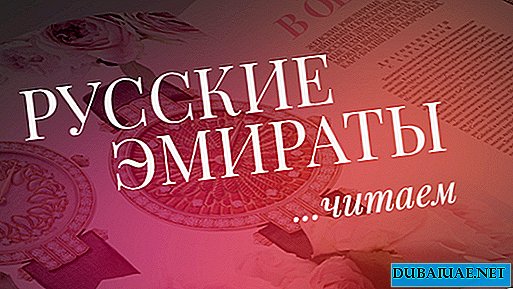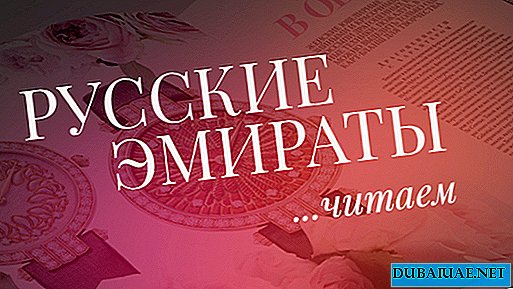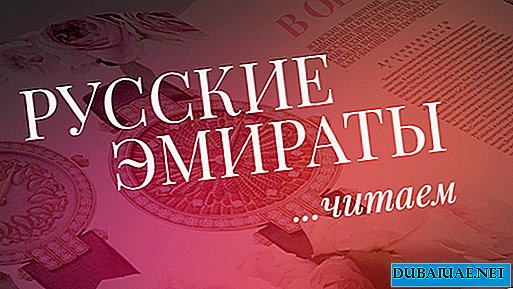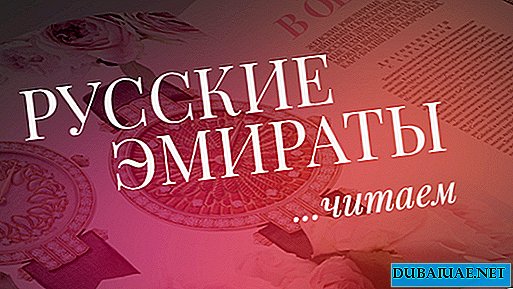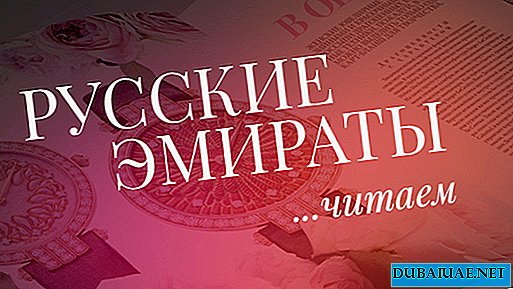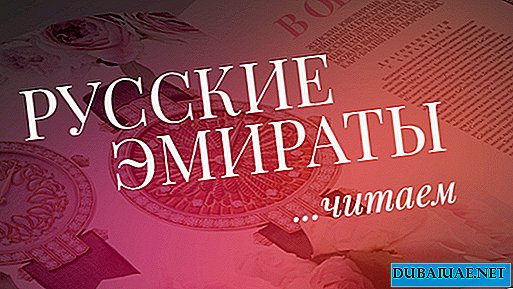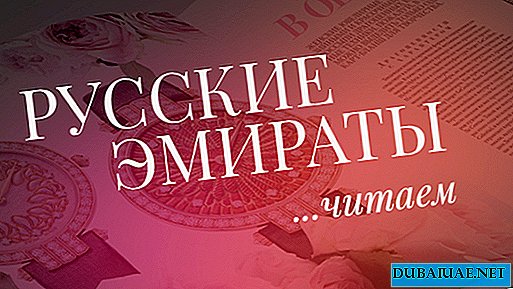DUBAI NAME OF THE CITY OF GOLD AND THE DIAMOND NODE OF THE WORLD ON THE NEW SILK ROAD. TODAY VOLUMES OF TRADE IN PRECIOUS STONES AND METALS ARE BOUND BY BILLION DOLLARS, HERE YOU CAN PURCHASE JEWELRY PRODUCTS OF THE MOST FAMOUS WORLD BRANDS. BETWEEN THESE RESIDENTS OF Sultry ARABIA DO NOT FORGET ABOUT THEIR OWN JEWELRY TRADITIONS.
With the advent of the era of oil prosperity, the United Arab Emirates has increasingly come to be rightly called the "golden coast." Here are the stores of all the largest jewelry houses, and in the emirate of Dubai alone, a quarter of the physical volume of world gold trade is concentrated (during sales, it is bought here more than 200 kg per day). Against the backdrop of the radiance of luxurious shop windows in huge shopping malls and in the famous gold markets, the traditional silver jewelry that the local craftsmen made for centuries and worn by the ancestors of the emirates look inconspicuous. However, it is precisely in the modest charm of "Bedouin silver" that not only the true heritage of the UAE itself is hidden, but also an amazing mosaic of jewelry traditions of the whole world.
In fact, the interweaving of global achievements and local flavor in the emirate lands began a long time ago. Arabian jewelry traditions are unique in this regard. On the one hand, coastal zones, especially along the Persian Gulf, have long been connected by sea trade routes with many regions of the world. It was from Arabia that the majority of Arabs settled throughout the Middle East. These ties could not but lead to a mutual enrichment of artistic traditions. On the other hand, the desert regions of the Arabian Peninsula have nevertheless been relatively isolated from the outside world throughout history. Therefore, if military or trade contacts once brought here any cultural tradition, for example, in the manufacture of jewelry, then it could be reproduced for centuries in its original form and convey to us the spirit of bygone eras and distant countries where these traditions have long been suppressed ...
The history of jewelry in the lands of the UAE can tell us a lot. On the territory of the country there are almost no archaeological sites where ancient jewelry could not be found. Even in the late Stone Age (6-4 millennia BC) people made chains and bracelets from shells, stone and bone beads. Some sinks demonstrate skillful carving and mother-of-pearl techniques. In the museums of the emirates of Fujairah and Ras Al Khaimah, you can see some precious metals (gold and silver) of that period.
It is amazing that even in those immemorial times, trade and cultural contacts were established with the civilizations of the Indus Valley - contacts whose importance has not diminished for millennia. Gemstones such as agate and carnelian (a type of chalcedony) were brought here from these regions, especially from Gujarat. During the culture of Umm al-Nar (named after the island in the emirate of Abu Dhabi), which existed from 2500 to 2000 BC. e., jewelry from numerous beads was put on the deceased.
In the burial of al-Sufuh in Dubai, about 13 thousand beads were discovered. Many finds are presented in the Emirate Museum. Small beads were widely used, which were made in the Indus Valley from so-called soapstone or earthenware. The era of Umm al-Nar brings back some "precious" associations. During this period, the modern Musandam peninsula in Oman, and possibly all the lands of Oman and the UAE, are found in Sumerian cuneiform texts called Magan. The legend tells that it was there that the famous mines of King Solomon were located. However, for this honor, Saudi Arabia and Israel can argue with Magan ...
The period of Wadi Suk (2000-1300 BC) seems to include the earliest examples of jewelry "excesses", so characteristic of modern Emirates. As now, their appearance was probably due to the accumulation of wealth. The region successfully traded copper, for example, with the ancient Mesopotamian city of Ur. A reflection of the abundance of steel plates of gold or electrum (the so-called gold nuggets with an admixture of silver). They were made in the form of a pair of animals, whose backs were connected, and the tails are often twisted like a spiral. Apparently, some artistic influences manifesting themselves in the traditional Bedouin jewelry up to the present day are also associated with the aforementioned Ur. This city was famous for its gold and silver craftsmen mined in Kurdistan.
Many other ancient countries also influenced the jewelry traditions of local residents. For example, Bedouin necklaces made of silver and colored beads of different sizes are made in a style that echoes the style of classical Antiquity. And the peculiarities of making fasteners for them almost completely correspond to the technology that was used in ancient Greece during the time of Aristotle. The use of ringing coins and bells was characteristic even of Ancient Rome and Byzantium. Since antiquity there has also been widespread use in the "Bedouin" jewelry art of brooches - fasteners for clothes, office workers and as ornaments. The Greco-Roman techniques of filigree and chain weaving were also preserved by the Bedouins. Phoenician merchants connected Arabia with distant Celts: here you can find bracelets dotted with patterns, indicating the influence of their style. Ancient Persia also had a noticeable effect on the jewelry traditions of the nomad Arabs. Finally, the famous eye motif (usually made in the form of a blue bead with blue, black and blue dots), which is common in all Arab countries and, according to many people, protects from the evil eye (which the Arabs call the "envious eye"), obviously leads its story from ancient Egypt. Perhaps, the inhabitants of the Persian Gulf coast from ancient times believed in the wonderful properties of soapstone.
The magic power of jewelry
The birth of Islam, of course, had a significant impact on the jewelry art of the Arabs. The new religion introduced the principle of strict monotheism, forbade portraying living beings, urged Muslims to abandon excessive love of gold and limit themselves to silver. But Islam did not supplant numerous past influences, but rather entered into an amazing symbiosis with them.
Nomads in the Middle East still believed in the magical power of certain jewelry. The Bedouins still enjoyed popularity, for example, the image of the head of a snake, which was supposed to keep the owner from the "evil eye". The Arab conquests included many rich civilizations in the cultural orbit of Islam - for example, Persian and partly Byzantine, which also affected jewelry. So, the Arabs adopted the Persian traditions of engraving, inlay and filigree. On one of the chains from Jordan, you can find both a crescent (a symbol of Islam) and a Christian cross; on Omani jewelry - the surahs of the Koran and the name of the Indian deity Hanuman ...
The main artistic feature of Islamic jewelry was finely crafted details and a variety of colors. Interestingly, precious stones were often replaced with glaze or glass, even in exquisite gold jewelry: although these materials did not have great value in themselves, but they gave the entire product the necessary color scheme.
A rosary was sometimes made from Karnelian or ivory (in Arabic, "misbaha" or "tasbih"). Rosary penetrated into the Middle East through India and began to be used by Christians and Muslims (there is reason to believe that the Catholic rosary - traditional rosary - was borrowed from the Arabs). Sorting through them helps to remember the number of repetitions of a particular ritual phrase, and in worldly life - to concentrate or relax, to express with the help of the sound of beads the whole gamut of feelings. The rosary usually consists of 33 or 99 beads. For Muslims, the second number is the number of names of Allah. For Christians, the first number indicates the duration of Christ's earthly life, and the second indicates his work in three (i.e., the Trinity). But there were giant rosaries in the Muslim world - consisting of 1000 beads the size of an egg, they were used in Egypt by mourners at the funeral when repeating the Islamic formula of worship 3,000 times!
Jewelry Miracles of the Abbasids
Of course, the most luxurious jewelry was made far from desert Arabia - in the populous capitals of Muslim states such as Damascus, Baghdad, Cairo. During the time of the Abbasid dynasty, which ruled in the Caliphate in the VIII-XIII centuries., Baghdad turned into the fashionable capital of the world, and clothes - into genuine jewelry. Even the robes of rich people were painted in gold. The most notable court ladies measured emeralds and rubies not by carats, but by kilograms! Some idea of the jewelry miracles of the Abbasid period is given by the description of the visit of the Byzantine ambassadors to the court of Caliph Muktadiir. Public finances were already showing signs of crisis, and it was necessary to impress foreigners with external splendor. So, after waiting two months, the Byzantines went to the caliph through the ranks of horsemen with gold and silver saddles.
These are the “jewelry” details of this technique given by the historian Hilal al-Sabi (forgive him for some exaggeration!). The ambassadors saw, among other things, 38,000 curtains of golden brocade; an artificial pond and a river of dazzling shining tin with four boats, decorated with gold, silver and brocade; a tree made of gold and silver, with birds of the same metals (sometimes the tree swayed and the birds sang) and fruits made of precious stones, is the envy of many subsequent monarchs. The Caliph himself sat on a throne of rare ebony (a kind of wood), was dressed in golden brocade, and 16 rows of precious stones were placed on his sides ...
There is reason to believe that the Catholic rosary - the traditional rosary - was borrowed from the Arabs. Sorting through them helps to remember the number of repetitions of a particular ritual phrase, and in worldly life - to concentrate or relax, to express with the sound of beads the whole gamut of feelings
Another major center of jewelry in those days was the abundant Muslim Spain. Byzantium could envy Cordoba in the skill of processing precious stones, gold and silver. Developed here and the technique of working with ivory and mother of pearl. Some experts point to an amazing example of the interaction of cultures - one of those that Islamic jewelry art provides in abundance. They believe that the similarity in the material and design of the jewelry of the Bedouins and the American Indians is explained by the fact that the Muslim jewelry traditions that developed in Spain were then brought to the New World by the Spanish conquistadors. It is noteworthy that before their arrival, the Indians never used silver or turquoise to create jewelry.
Meanwhile, the inhabitants of the harsh Arabian deserts made things much less demanding, but full of charm. Despite the rich variety of "regional" materials, styles, and customs, typical "Bedouin" jewelry unites several features. The most common material was silver. Jewelers softened the material, forged it until it became flat, and then gave it the desired shape - for example, cut or forged. They decorated the metal with engraving, stamping, enameling, granulation, inlays. Often inscriptions were made on products, for the most part - quotes from the Koran. Silver was not only mined from the bowels, but also smelted from coins popular in the Middle East - thalers of Theresa and pesos, as well as ancient jewelry. Jewelry, which was the personal property of a woman, she sometimes sold in difficult times.
So, some of the Bedouin products that we can buy now probably contain silver, which has been smelted many times over the centuries. Enamel, like glass, was made from a mixture of sand, potassium, minium and soda. The melting point of this mixture was supposed to be lower than the melting temperature of the metal, and its surface was completely fat-free and dust-free so that the enamel would stick. It is curious that Muslim jewelers used to love to use the famous Murano glass for making enamel, and beads were often made for the Islamic world by Bohemian craftsmen (Chinese are now used).
Other interesting materials for making jewelry are leather and rope. They were widely used on the Arabian Peninsula. For example, silver items were attached to the belt using leather fasteners, and beads were strung on a rope and thus created bracelets or headbands. The owner's comfort was served by a leather or cotton lining of the head rim, flexible bracelets, the silver links of which were connected by ropes. Leather strips are often artfully woven. Necklaces were also made on the basis of the threads, which, however, wore out too quickly. Now in the markets it is very difficult to find a chain with a whole thread also for the reason that enthusiastic buyers endlessly turn over old piled up jewelry in search of something original.
The style features of the "Bedouin" jewelry of the Persian Gulf region were determined, of course, by the special geographical position at the crossroads of trade routes, close ties with India, as well as the widespread use of pearls, which are so rich in local waters, in jewelry.
Arabic style
Jewelry at all times and among all peoples were not simple trinkets, but performed important social functions in people's lives - from the caliph to the village woman. The same was the case with the ancestors of modern emirates. Jewelry indicated the social status of women. They were incredibly diverse. Numerous chains, necklaces, earrings, hand and anklets; rings worn on a particular finger; rims framing the head or face; jewelry for the chin, forehead and hair; crowns, brooches, coins mounted on scarves; boxes for storing prayers; even the belts on which boxes for carrying scissors, thimbles, clothespins, carcasses, perfumes and, finally, ivory boards with a pencil for drawing notes fit in - all this accompanied women at every stage of their life. When he began to walk, the child was hung with a bracelet on his ankle so that he could move more. A certain type of earrings, for example, was worn mostly by young girls. The bride had a dowry and received gifts from the groom's family primarily in the form of jewelry. Then the husband usually gave his wife jewelry every time she gave him a child ...
However, jewelry has long had a symbolic meaning. It was believed, for example, that turquoise can protect against the evil eye, and that this stone shines when its owner is happy, and dims when he is sad. The same function, as we saw, was performed by beads in the form of eyes and the head of a snake. And to drive away evil spirits were small ringing bells.
Especially popular is the image of the palm, which became widespread as an amulet before the advent of Islam, and after it became associated with the hand of Fatima - the daughter of the Prophet Muhammad and the wife of his cousin Ali. The worship of the number five is also connected with it - the number of fingers on the palm, the pillars (main principles) of Islam and the daily prayers of Muslims. The palm can be directed with the fingers up - then it performs a protective function, or with the fingers down - in this case it symbolizes grace descending from heaven.
Sun, sea and sky
Associative value and colors. The "Bedouin" jewelry is dominated by red (a symbol of blood and heart, love or danger), blue (turquoise is widely used in Arabia for making rings and pendants), as well as yellow and green. The colors in the Arabian jewelry are the yellow-golden glitter of the sun and desert sands, the green-blue overflow of the sea, the endless blue of the sky caught and enclosed by the workshop’s hand ... And the white color was associated with the birth of a new life and protected nursing mothers and their babies.
With the advent of the oil age, the "Bedouin" silver began to give way to gold and fashionable Western products. The Bedouin lifestyle has changed, the diversity of regional styles has decreased. Back in the mid-1960s. - until the Emirates gained independence - Dubai has become a major world center for gold trading. In the first half of this decade, about 70 tons of metal were transported through the emirate, and only in 1971 (when the UAE became a sovereign state) - 215 tons. Emirate merchants ordered gold in Western Europe, stored in rapidly developing Dubai banks, and then sold it in India, Pakistan, Southeast Asia and the Far East. The transportation of precious metal itself was an amazing combination of modernity and tradition. Gold was delivered from London or Paris by plane, and it was already transported to India and Pakistan along the millennium-long trade route in traditional dhows, but equipped with diesel engines of 600 horsepower ...
Particularly popular is the image of the palm, which became widespread as an amulet before the advent of Islam, and after it became associated with the hand of Fatima
Jewelry Records
Over the years of modern development, the Emirates have become one of the leading countries in the consumption of gold per capita. According to the World Gold Council, in 2013, the Emirates bought over 77 tons of this metal. This is about three times more than the acquisitions of the residents of the remaining small countries of the Persian Gulf combined (except for Saudi Arabia, which the Emirates also overtook), and almost 20 tons higher than Egypt (10 times more populated country).
The most colorful manifestation of the ongoing "gold rush" - the famous and always crowded bazaars of Dubai (the market in Arabic - "bitches"). The "old" gold market is located next to Bani Yas Square and the metro station of the same name in the Deira area, as part of an entire trading town. On the other side of Dubai Bay, which can be crossed on a traditional Abra boat in five to ten minutes, another group of bazaars is located in the Grand Mosque. In the old market you can find jewelry for every taste from 18-carat (white, yellow or pink), 21-, 22 and pure 24-carat gold, with which overloaded display cases of more than three hundred shops sparkle. Silver and precious stones are also sold. There are decorations made in the western style, and products in which the Arab tradition is creatively reworked. Products can be made to order as soon as possible. It also presents souvenirs such as gold swimsuits. Shopping can be done wholesale and retail. The market attracts periodic lotteries and sweepstakes (you can win up to 25 kg of gold!) And some of the lowest prices in the world.
Of course, the Arab female is a place where bargaining is not only appropriate, but also necessary for the mutual joy of the buyer and seller. The lowest price can be brought down in the evening, by the end of the working day. Other gold markets have appeared in Dubai (for example, in the Bar Dubai area on Mina Street). And on Sheikh Zayed Street, a whole "Park of Gold and Diamonds" was built, combining 90 stores of leading jewelry brands and more than a hundred workshops. Finally, large modern malls (for example, The Dubai Mall or the Madinat Zayed center in Abu Dhabi) combine under one roof built in a traditional style, but with an ultra-modern gloss boutiques of the most famous Western brands. Everywhere there is a very strict state quality control of jewelry.
Many of the "jewelry" records of the Emirates gained great fame and even won a place in the Guinness Book of Records. In 2008, a silver coin coated with gold was cast, which had a meter diameter and weighed 165 kg. Then, at the Old Gold Market in Deira, the heaviest gold ring in the world was made (weighing almost 64 kg, of which more than 5 are the mass of precious stones). It was followed by another, but clearly not the last masterpiece - the most expensive Christmas tree ...
Emirates, however, know how not only to spend on precious metals and stones, but also to earn on them. The country is increasingly playing the role of a global center for jewelry trade - the role that historically belongs to it by right. Now the Emirates are striving to revive the traditions of the Great Silk Road between Europe and Asia - at least in its southern, marine part.
It is not for nothing that the Minister of Higher Education and Scientific Research of the UAE, Sheikh Nakhayan bin Mubarak, quoted the words of the great Arab historian of the 9th-10th centuries. Muhammad at-Tabari: "There are no obstacles between us and China." Any goods could be delivered by sea. Jewelery has always been an important component of trade exchange. Nowadays, we are talking primarily about gold and diamonds.
Not only a quarter of the world gold trade passes through Dubai - in about a decade, the emirate managed to turn into a global center for the sale and processing of diamonds and seriously challenge the Belgian Antwerp, in which the diamond industry has more than five hundred years of history. Dubai has everything to confirm its ambitions: a favorable geographical position between the leading countries in Africa, where diamonds are mined, and the main markets for stone processing and diamond sales in Asia - China and India, a favorable business climate and security. The emirate is taking steps to end the smuggling of precious stones.
Large specialized exhibitions are held in Dubai. For example, in March 2013, the Dubai Diamond Conference was organized, and in December, the Dubai International Jewelery Week. In the emirate, the Dubai Gold and Raw Materials Exchange, the Dubai Diamond Exchange, the Dubai multi-commodity exchange (it was located in a skyscraper called "Almas", which in Arabic means "diamond") were created. All these are large financial centers that support the work of the jewelry industry.
Some precious materials are used even in Emirate architecture. So, the amazingly beautiful Sheikh Zayed Mosque in Abu Dhabi boasts gilded chandeliers. In the luxurious hotel The Emirates Palace, also located in the capital, many interior details are also covered with gold - moreover, there are vending machines for selling gold bars to everyone, and branded cappuccino is served with a scattering of edible gold petals ...
It is very important that in the fast pace of the global economy and the pursuit of "jewelry" records, the Emirates are still beginning to pay more attention to maintaining local traditions. There are local firms that produce antique-style jewelry. Sharjah has a special museum dedicated to traditional jewelry. There are awards designed for the most successful local designers or creators of precious masterpieces in the Arab art tradition. Such, for example, are special categories of awards for jewelry design, the Ibdaa prize (in Arabic, “creativity”). And in 2006 even a special series of stamps with images of the best examples of traditional jewelry was released. It can be assumed that precious elements will be increasingly used in clothes thanks to the young generation of emirate designers who have relied on the development of local traditions in fashion.
The Arabic word "jawhar" can be translated both as "jewelry" and as "being (affairs), essence, substance, matter." In the Emirates, it seems, they really adhere to the motto: "Well, if you make a thing from any material, then ideally it should be precious material." But on the other hand, the essence of the jewelry traditions of the Emirates is still not in soulless matter, but in how the amazing creative abilities of their masters in the past and present gave artistic value to any material - from a glass bead to diamond.


